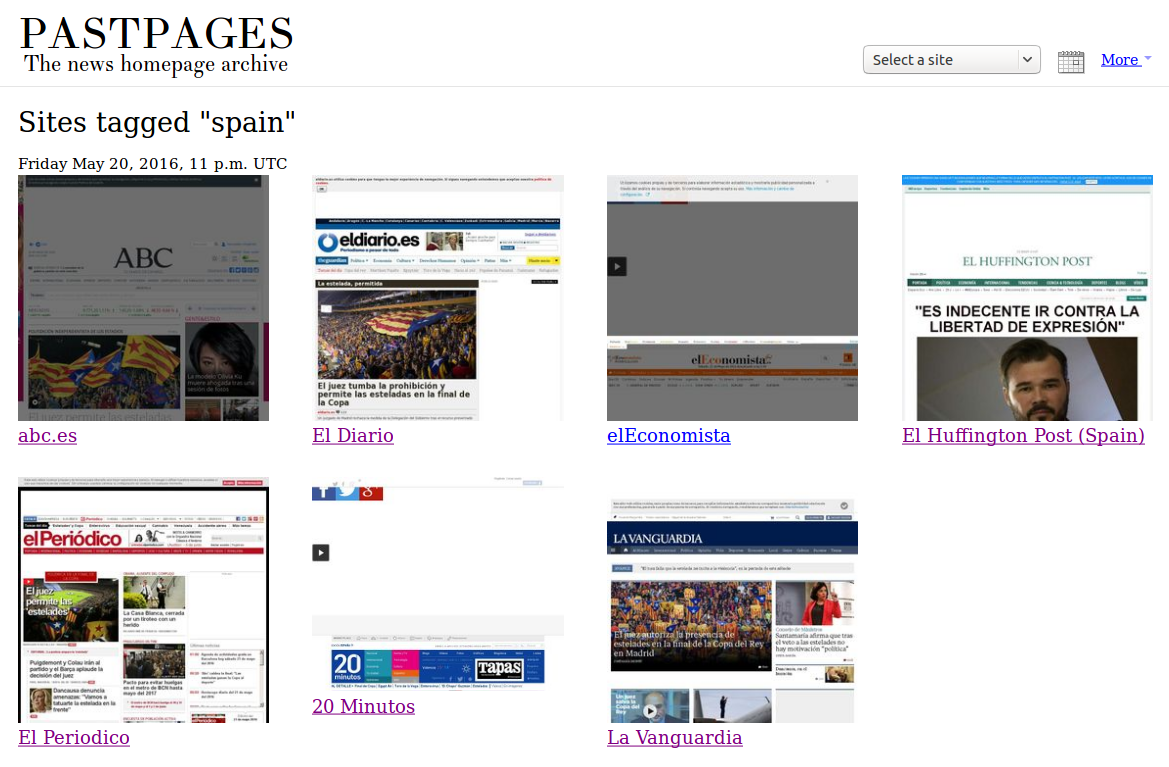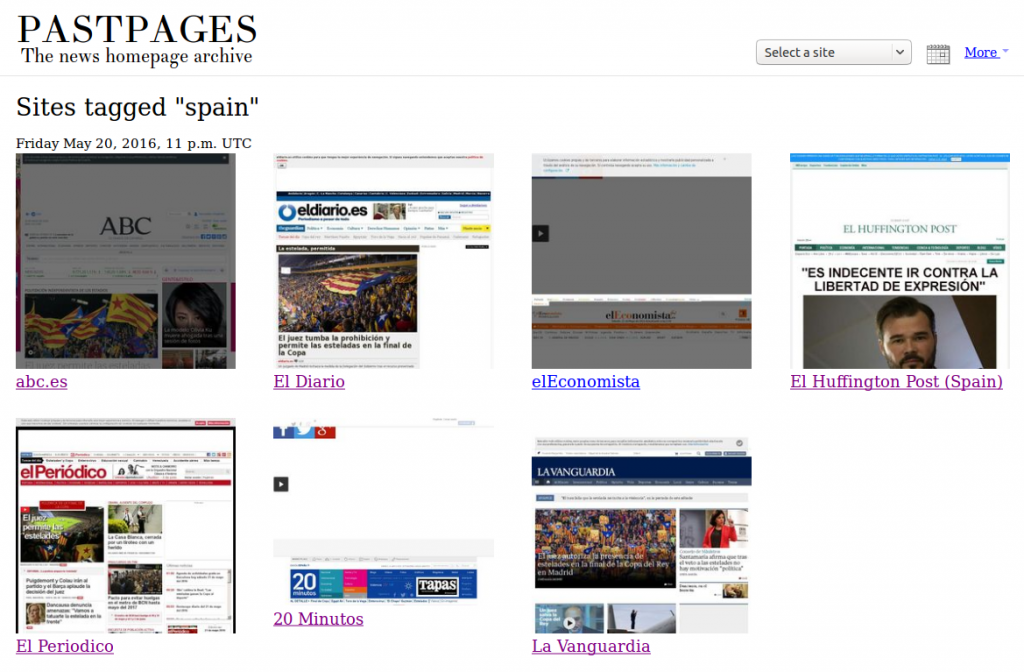Después de unos ajustes al resumen que preparé para el seminario de hace unas semanas he presentado el Abstrac Research Plan a la comisión de doctorado. El cambio principal es centrar o dar más peso al estudio de las redes sociales (social networking sites) en el ecosistema de medios, que son que ha cambiado el panorama de la comunicación en los últimos tiempos. Dentro de “mass media” incluyo “news media” y “social media“. La idea es usar el caso de la cobertura de corrupción para realizar esta investigación.
A finales de mes tengo que presentar el plan de investigación completo (4.500 palabras) así que ya estoy trabajando en ello. A ver cómo este nuevo enfoque me hace reestructurar y escribir lo que tenía hasta ahora.
Mientras, pastpages.org se ha puesto a funcionar para capturar las portadas de los principales diarios online que le pasé a Ben Welsh ¡thank you! No está funcionando del todo bien, no todos los periódicos aparecen etiquetados como “Spain” pero ya va empezando a existir el archivo de periódicos online en España. De momento sólo archiva la imagen de la portada, no el código html. Esa funcionalidad solamente está disponible para ciertos periódicos.
El #colorcorrupción será tema de tesis. A las portadas de papel añadiré las de diarios online. Lista tentativa: pic.twitter.com/0nWlYAhUzv
— numeroteca (@numeroteca) April 25, 2016
Además, tendré que leer las recomendaciones de Ismael Peña, mi tutor, sobre el tema de la influencia de los social media. Jóvenes clásicos que hay que no he leído todavía que me ayudaran a tratar el tema de la importancia de los medios sociales en la web: hablan del “daily me” en Being digital (1996) de Negroponte, las “echo chambers” en Republic.com 2.0 (2009) o sobre amateurs “Our social tools remove older obstacles to public expression, and thus remove the bottlenecks that characterized mass media” en Here comes everybody: How change happens when people come together (2009) de Shirky.
Pego aquí el abstract que entregué este domingo. Se aceptan y agradecen consejos, sugerencias.
Title: The color of corruption coverage in Spain. Agenda setting in a polarized media ecosystem.
Objectives, hypothesis and questions
By selecting and framing stories mainstream media help determine what is important and what not. Mass media play then a key role in shaping public opinion. Since the seminal article The agenda-setting function of mass media was published in 1972, and specially during the last decade, we have witnessed the emergence and the growth of influence of social media. Social media users (writers/readers) help to disseminate the news, but are also able to participate directly in the selection, creation and framing of the stories to modify the agenda setting traditionally dominated by the mainstream media (Negroponte 1995; Shirky, 2008; Sunstein, 2001). News media remain as key players in mass media ecosystem but they are no longer alone in the way political reality is shaped. How are social networking sites changing the agenda-setting role of traditional media?
How is the dialogue between social networking sites and mass media and how they drive attention to certain stories? We will use the topic of corruption in Spain to study this question.
In the past years, corruption cases in Spain have involved almost every institution in the country. These scandals are usually brought to light by news media and amplified by social media. Every week, a new investigation is unveiled provoking an increasing sense of indignation. As there is a wide range of actors involved in the scandals it makes corruption an appropriate field of research to analyze the role of social media in a polarized media ecology, where Spanish media outlets are traditionally aligned with political parties.
We will research the different variables that shape mass media coverage and public perception such as the main actors involved in a corruption case, the medium where it is published, the publicity given to the story or when it is published. Through the analysis of corruption coverage we are going to measure how news media protect or attack certain parties and institutions by hiding or promoting certain stories. The underlying objective is to update theories about the Spanish partisan media ecosystem.
In a system where people select the newspaper more aligned to their ideology: what comes first, the agenda setting and framing by mass media or the general public predisposition? We are specially interested to see how the situation evolves in a political situation that is shifting from a bipartisan system to a four players game, where new online news sites and networking sites are entering with strength the mass media ecosystem.
Methodology
The unit of analysis of this research are corruption stories in front/home pages of paper and online newspaper newspapers and social media messages in Twitter. We want to measure the importance given by the mass media to certain topics and compare it to the discussion in social media so that we can infer similarities and differences in both their characteristics and determinants.
We will quantify corruption coverage by measuring: the number of news; the size, by using the percentage of surface dedicated to the topic; the “color”, which institution was related to corruption. Informed by other studies and literature in the field of corruption coverage and media studies (Rivero & Fernández-Vázquez, 2011; Baumgartner & Chaqués Bonafont, 2015) we will also study the framing of corruption (Costas-Pérez, Solé-Ollé & Sorribas-Navarro, 2012), whether the coverage is neutral or negative or defensive and giving a positive view.
Whereas front page analysis is not new, we propose the use of new methods to have better and more accurate metrics that take in account size and visual aspect of the analyzed stories. We are going to use PageOneX.com to analyze front pages of paper newspapers and StoryTracker (http://storytracker.pastpages.org/) to analyze home sites of online news sites. Our collection of data can also be compared with other analysis of front pages conducted by the Spanish Policy Agendas project (Chaqués-Bonafont, Palau & Baumgartner, 2014) in the two largest newspapers in Spain: El País and El Mundo.
To analyze social media messages in Twitter we will use the software and data set developed by Mari Luz Congosto at the Universidad Carlos III available at http://t-hoarder.com/. We will quantify conversations about topics by the number of messages, retweets, number of users and the topic they are referred to. We will also analyze user networks and the dissemination of tweets by the mainstream media in Twitter.
To provide related information to our stories data set and in order to measure impact in public opinion we are using two different approaches, existing public opinion surveys and focus groups.
- The monthly national survey, “the barometer”, of the Centro de Investigaciones Sociológicas (CIS), that asks about the three more important problems for citizens, where corruption and fraud is since 2013 in the top three.
- Focus groups to provide context to understand how people “read” front pages, how they judge about scandals along personal ideologies. We want to contrast data from media coverage with direct perceptions of readers. Participants will be selected to have diverse affinity to political parties and different ideologies. We will use the newspapers front pages of the week as a starting point for a conversation about corruption.
–
Próximamente espero renovar el tema de wodpress de este blog. Stay tuned!

